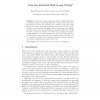Free Online Productivity Tools
i2Speak
i2Symbol
i2OCR
iTex2Img
iWeb2Print
iWeb2Shot
i2Type
iPdf2Split
iPdf2Merge
i2Bopomofo
i2Arabic
i2Style
i2Image
i2PDF
iLatex2Rtf
Sci2ools
FC
2009
Springer
2009
Springer
Coercion Resistant End-to-end Voting
End-to-end voting schemes have shown considerable promise for allowing voters to verify that tallies are accurate. At the same time, the threat of coercion has generally been considered only when voting devices are honest, and in many schemes, voters can be forced or incentivized to cast votes of an adversary’s choice. In this paper, we examine the issue of voter coercion and identify one example method for coercing voters in a scheme by Benaloh. To address such attacks, we present a formal definition of coercion resistance for end-to-end voting. We then present a new scheme, extended from Benaloh’s, that is provably coercion resistant. In addition to providing accuracy and coercion resistance, our scheme emphasizes ease-of-use for the voter. Key words: end-to-end voting, coercion, privacy, cryptography
Related Content
| Added | 26 May 2010 |
| Updated | 26 May 2010 |
| Type | Conference |
| Year | 2009 |
| Where | FC |
| Authors | Ryan W. Gardner, Sujata Garera, Aviel D. Rubin |
Comments (0)

